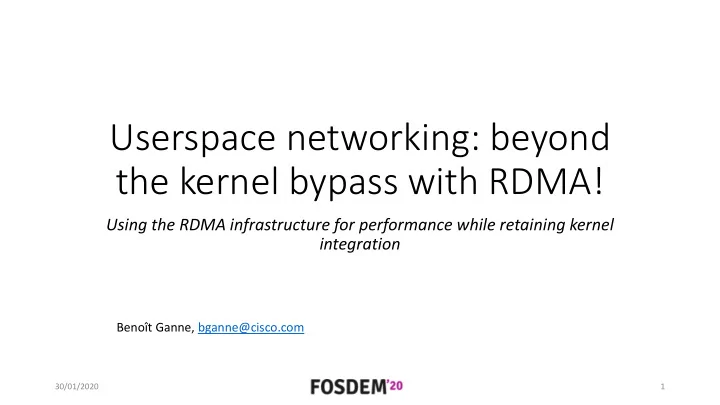

Userspace networking: beyond the kernel bypass with RDMA! Using the RDMA infrastructure for performance while retaining kernel integration Benoît Ganne, bganne@cisco.com 30/01/2020 1
Why a native network driver? • Why userspace networking? VPP IPv4 forwarding PDR, 1core, 2M routes • Performance (avoid kernel overhead) 18 • Update network functions seamlessly (no reboot required, containerization) 16 +23% • Why your own network driver? 14 • Performance (metadata translation tax, feature 12 tax) Mpps 10 • Ease-of-use (no reliance on hugepages, etc.) 8 • Why you should think twice? 6 • No integration with kernel (interface fully owned by userspace) 4 • You care about rx/tx packets but device 2 initialization & setup is 95% of the work • Hardware is hard (more on that later) 0 Native DPDK Source: https://docs.fd.io/csit/master/report/vpp_performance_tests/packet_throughput_graphs/ip4-2n-skx-xxv710.html 30/01/2020 2
RDMA • « Remote Direct Memory Access » • Designed for message passing and HW RNIC data transfer • Has evolved to use Ethernet transport (iWARP, RoCE) Kernel RDMA uAPI • Key properties DMA • Hardware offload • Kernel bypass libibverb • Zero Copy data transfer • High network bandwidth User VPP ➔ Great for kernel networking! 30/01/2020 3
Extending RDMA for Ethernet Incoming packets are steered to Linux netdev or userspace application based on flows • Not designed for efficient Ethernet communication – but! HW RNIC • Ethernet-capable HW (initially for transport) • High performance (200Gbps today) DMA • Kernel bypass with well established API RDMA and native Linux kernel support Kernel RDMA uAPI Netstack DMA • Why not extend it to support userspace networking? • Introduce new IBV_QPT_RAW_PACKET libibverb queue pair type User • Support for bifurcation with flow steering • Keep your Linux netdev VPP • Support MACVLAN, IPVLAN model… 30/01/2020 4
Using RDMA for Ethernet How to send 20 Mpps with 1 CPU 1. Get a handle to the device you want to use 2. Initialize queues • Queue Pair (QP) = Submission Queue (SQ) + Completion Queue (CQ) • Protection Domain (PD) = where the NIC is allowed to read/write data (packets) 3. Send packets • Put Work Queue Elements (WQE – kind of IOV) in SQ • Notify new packets to send • Poll CQ for completion Full example at https://github.com/bganne/rdma-pktgen 30/01/2020 5
Going deeper with Direct Verbs • RDMA user API is ibverb • Simple enough, mostly standard, open-source • Not full performance (metadata translation tax, feature tax) • Direct Verbs • ibverb extension to access DMA ring-buffers directly • Hardware-dependent! • Setup done through ibverb, then get DMA rings addresses 30/01/2020 6
VPP native RDMA driver • ibverb version • Available since 19.04 • ~ 20 Mpps L2-xconnect per core • Direct Verb • Development underway • Hardware is hard : while trying to debug my driver I almost bricked my NIC • Next • Add support for hardware offloads (checksum offload, TSO) 30/01/2020 7
A call to action • We love this model • No need to write code boilerplate to initialize the NIC: we can focus on what matters (rx/tx packets) • Seamless integration with Linux kernel • Great performance • But is has limitations • Need RDMA-capable NIC: must support Hardware security model, etc. • Only supported on Mellanox for now • Could other technologies enable this approach? • Disclaimer: a bit outside of my domain knowledge here… • vfio-mdev? • AF_XDP? 30/01/2020 8
Recommend
More recommend